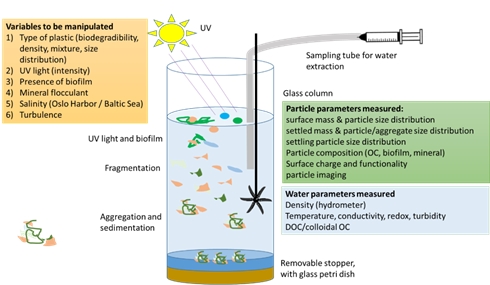Work packages WEATHER-MIC
WEATHER-MIC is structured in seven scientific and one administrative work packages.
WORK PACKAGE 1: Artificial aging and fingerprinting of MP debris
Lead: ACES
Objectives
- To develop laboratory protocols that simulate the weathering of primary and secondary plastic debris in the marine environment and provide samples of weathered polymers and leachate for further experiments in WP2 (column-weathering experiments) and WP6 ((eco)toxicity)
- To develop non-target screening methods based on liquid chromatography/mass spectrometry to identify free chemicals liberated from plastics under simulated weathering conditions, including degradation products of plastic polymers, additive chemicals and pollutants sorbed to the plastic from the marine environment
- To develop methods to identify and characterize plastic debris based on the “chemical fingerprint” liberated under simulated weathering conditions, and to use the “chemical fingerprint” to trace likely sources of plastic debris to the marine environment
- To develop and validate methods for enhanced characterization of MP behaviour by physical parameters and particle imaging
WORK PACKAGE 2: The influence of weathering on MP aggregation and settling
Lead: NGI
Objectives
- To develop a series of lab-scale column experiments simulating weathering on diverse MPs in waters representative of the Baltic Sea (low salinity) and Oslo Harbour (mid to high salinity) under diverse conditions
- To characterize the changes in MP-aggregates using diverse measurements (visualization, particle size distribution, density), that can be used to better account for field observations (WP5)
- To provide a model to account for the influence of weathering and sedimentation, that can be implemented in a large scale estuarine model (WP4)

WORK PACKAGE 3: Effects of biofilm formation on the vertical distribution of plastics in situ and trophic transfer
Lead: ACES
Objectives
- To evaluate natural loads of biofilms on MPs along a vertical profile of the water column and along the inshore-offshore gradient in the northern Baltic proper
- To assess effects of MPs on bacteria production in sediment and overlaying water using microcosm experiments
- To evaluate fitness related consequences (growth, recruitment success and population growth) for grazers (benthic and pelagic copepods) exposed to MPs with varying biofilm load
WORK PACKAGE 4: Modelling extension to real world environments
Lead: KUL
Objectives
- To evaluate different modelling options for incorporating the laboratory test results to the real world
- To develop a one-dimensional (1DV) model to study current and wave effects on MP fate
- To develop a 3D demonstration model
WORK PACKAGE 5: Model validation and field evaluation
Lead: NGI
Objectives
- To collect sediment cores and water column samples in Oslo Harbor and Baltic Sea
- To analyse the MP content in the sediment cores and water column and compare with WP2 tests
- To match predictions in size distribution and profiles of MP with WP4 model predictions

WORK PACKAGE 6: Toxicological assessment of MP particles and leachates
Lead: UFZ
Objectives
- To screen toxicological effects of virgin and weathered MP and its leachates in environmental organisms according to OECD guidelines
- To evaluate toxicological effects of MP and its leachates on biofilm communities by applying the concept of pollution-induced community tolerance (PICT)
- To provide mechanistic information on the impact of plastic leachates using reporter-gene bioassays

WORK PACKAGE 7: Estimation of environmental risk posed by virgin and weathered MP, and the leachates
Lead: UFZ
Objectives
- To combine data on MP exposure and fate from WP1-5 with effect data obtained in WP6
- To provide estimations on environmental risk posed by weathered MP
- To provide knowledge on the most critical MP properties after the weathering process (such as shape, roughness, most toxic fraction)
WORK PACKAGE 8: Project management, dissemination, communication and outreach
Lead: UFZ
Objectives
- To develop a dialog between the partners to facilitate scientific discussion, collaboration and maximize synergies from the experimental planning stage to the paper and report writing stage
- To establish a project website to maximize outreach of the conducted research to a range of target audiences, providing regularly updated information for the target groups of i) scientists, ii) regulators and other stakeholders and iii) the general public
- To identify key stakeholders in the participating countries (e.g. regulatory authorities, environmental interest groups, teachers) and develop good communication formats (such as white papers, press releases, teaching materials)
Published: 2016.03.25 | Last updated: 2017.03.22
